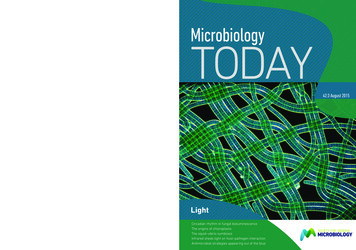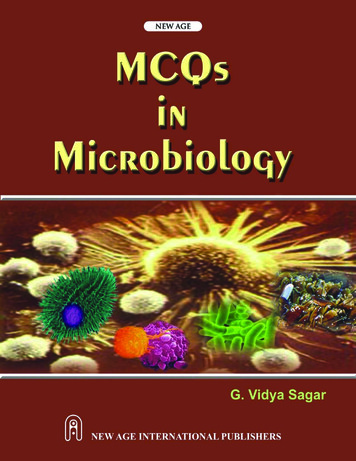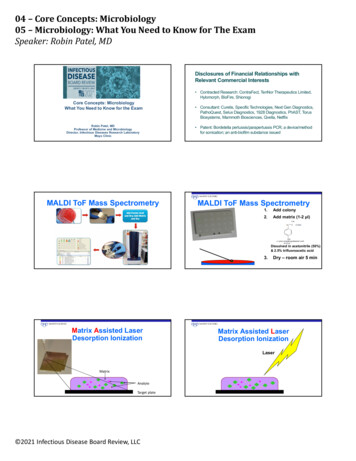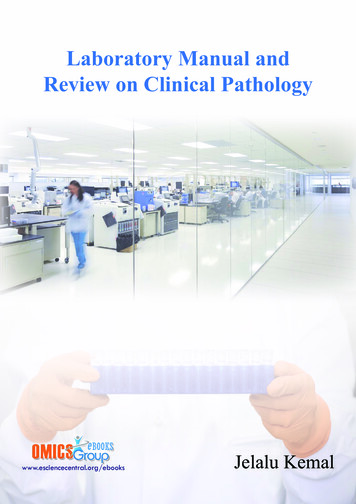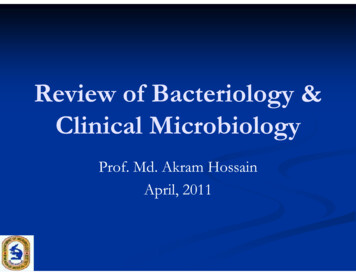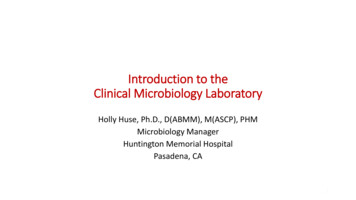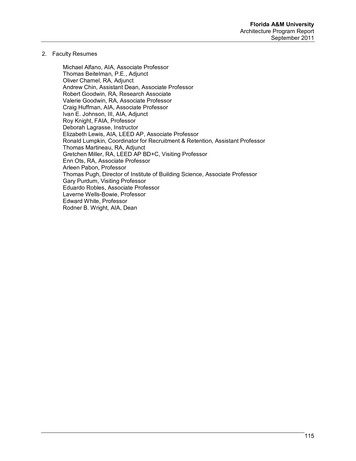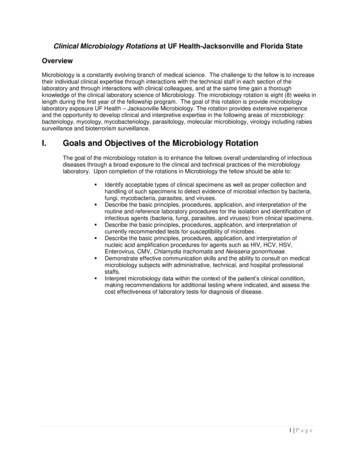
Transcription
Clinical Microbiology Rotations at UF Health-Jacksonville and Florida StateOverviewMicrobiology is a constantly evolving branch of medical science. The challenge to the fellow is to increasetheir individual clinical expertise through interactions with the technical staff in each section of thelaboratory and through interactions with clinical colleagues, and at the same time gain a thoroughknowledge of the clinical laboratory science of Microbiology. The microbiology rotation is eight (8) weeks inlength during the first year of the fellowship program. The goal of this rotation is provide microbiologylaboratory exposure UF Health – Jacksonville Microbiology. The rotation provides extensive experienceand the opportunity to develop clinical and interpretive expertise in the following areas of microbiology:bacteriology, mycology, mycobacteriology, parasitology, molecular microbiology, virology including rabiessurveillance and bioterrorism surveillance.I.Goals and Objectives of the Microbiology RotationThe goal of the microbiology rotation is to enhance the fellows overall understanding of infectiousdiseases through a broad exposure to the clinical and technical practices of the microbiologylaboratory. Upon completion of the rotations in Microbiology the fellow should be able to: Identify acceptable types of clinical specimens as well as proper collection andhandling of such specimens to detect evidence of microbial infection by bacteria,fungi, mycobacteria, parasites, and viruses.Describe the basic principles, procedures, application, and interpretation of theroutine and reference laboratory procedures for the isolation and identification ofinfectious agents (bacteria, fungi, parasites, and viruses) from clinical specimens.Describe the basic principles, procedures, application, and interpretation ofcurrently recommended tests for susceptibility of microbes.Describe the basic principles, procedures, application, and interpretation ofnucleic acid amplification procedures for agents such as HIV, HCV, HSV,Enterovirus, CMV, Chlamydia trachomatis and Neisseria gonorrhoeae.Demonstrate effective communication skills and the ability to consult on medicalmicrobiology subjects with administrative, technical, and hospital professionalstaffs.Interpret microbiology data within the context of the patient’s clinical condition,making recommendations for additional testing where indicated, and assess thecost effectiveness of laboratory tests for diagnosis of disease.1 P age
II.Competency Based ObjectivesPGY 4A.Patient Care B.Medical Knowledge C.Discuss the clinical and basic sciences as applied to Clinical Microbiology,including bacteriology, mycology, mycobacteriology, parasitology, specialsusceptibility tests, virology and molecular microbiology.Describe the cost-effective and clinically relevant usage of microbiologic tests,interpretation of culture and test results, and appropriate use of testmethodologies.Explain the technical methodologies involved in the performance of testing in allareas of microbiologyPractice-Based Learning and Improvement D.Discuss the clinically appropriate interpretation of microbiologic test results toensure the provision of excellent patient-focused care.Gather essential and accurate clinical information when a microbiologic testingpattern is in question to resolve possible conflicts.Utilize medical knowledge with the help of information technology to makeinformed decisions regarding outcomes, including recommendation forappropriate test follow-up.Interact with other health care professionals to provide compassionate,appropriate and effective relay of microbiologic information for effective andtimely patient care.Describe the systematic approach to the investigation and evaluation of clinicallyrelevant testingInterpret microbiologic tests to improved patient care.Apply systematic topical research to derive evidence based knowledge onmicrobiologic issuesDemonstrate the integration of clinical knowledge with microbiologic data toaffect patient care.Interpersonal and Communication Skills Demonstrate effective communication with clinicians in obtaining pertinent clinicalinformation to optimize patient careDemonstrate communication with laboratory technologists regarding processingand interpretation of patient specimensExplain the roles of other members of a health care team, including attendingstaff, other residents/fellows and laboratory technologists.Develop the appropriate interpersonal skills to supervise and/or interact withother laboratory personnel including supervisors and technologists.2 P age
E.Professionalism F.Systems-Based Practice III.Maintain strict patient confidentiality with all clinical and personal information:diagnosis, prognosis, test results, etc.Demonstrate compassion and empathy if dealing with patients and their families.Discuss methods of maintaining self-control during stressful and/or emotionalsituations with colleagues, house staff, technical staff, and doctoral staff.Attend bench rotations, Microbiology Laboratory Rounds, Epidemiology Roundsand meetings with the Microbiology Director consistently and punctually.Discuss the Utilization of a systematic and where applicable, a multi-disciplinaryapproach towards solving problems, reducing errors, and improving processes isessential.Explain how the microbiology laboratory fits in the larger context and system ofhealth care.Discuss utilization controls used in microbiology to minimize unnecessary testing.Consult with clinicians when appropriate to narrow diagnostic possibilities.Discuss the principles of quality control and procedures used in the Microbiologylaboratory.Knowledge to be AssessedKnowledge and understanding of the function of the Bacteriology Laboratory including butnot limited to: The collection, transport, direct smears, media selection and quality assurance ofclinical specimensUse of the diverse variety of bacteriologic mediaIsolation and identification of bacterial isolates from clinical specimensDrawing and processing of blood culture specimensMethodologies of antimicrobial susceptibility testingCollection, processing and identification of anaerobes from clinical specimensKnowledge and understanding of the function of the Mycology Laboratory including butnot limited to: The collection, transport and evaluation of specimensDirect methods of specimen examinationUse of fungal isolation mediaIdentification of specimen contaminantsIdentification of pathogenic and opportunistic yeasts and fungiMethodologies of antifungal susceptibility testingKnowledge and understanding of the function of the Mycobacteriology Laboratoryincluding but not limited to: Specimen collection and initial processingStaining methods for initial identification of mycobacteria and streptomycetesSelection of appropriate media for isolation and identification of organismsIdentification schema and methodology for mycobacteria and streptomycetes3 P age
Knowledge and understanding of the function of the Parasitology Laboratory including butnot limited to: Availability and use of transport/fixative media for enteric pathogensRecognition of stool pathogenic and non-pathogenic protozoa and helminthesRecognition of Plasmodium species in blood smearsMethodology for identification of Pneumocystis in respiratory specimensKnowledge and understanding of the function of the Virology Laboratory including but notlimited to: Collection, transport, evaluation of virology specimensCell lines and reagents for the isolation and identification of suspected virusesfrom clinical specimensCommercially available methodology for molecular determinations ofHIV viral load, HCV viral load, HCV genotyping, HSV, enterovirus and CMV viralloadMethodology for nucleic acid amplification testing for Neisseria and Chlamydiafrom appropriate clinical specimensIV. Methods of Achieving Objectives Laboratory rotation: Fellows are required to complete an 8-week rotation inMicrobiology. A rotation schedule is prepared by the Microbiology Director forthe fellow prior to the beginning of each rotation.Microbiology Laboratory Rounds: Fellows are required to attend dailyMicrobiology Laboratory Rounds, as instructed, during their rotation.Literature and case study review: Fellows will be given assigned reading andcase studies during their rotation. Fellows are expected to prepare for weeklydiscussions regarding the material. Fellows are expected to review and discusscurrent Microbiology literature.Epidemiology Rounds: Fellows will actively participate in Epidemiology roundswith microbiology and infection control practitioners during their rotation.Microbiology self-study: Fellows are given a series of CD-ROMs. Fellows areexpected to complete the study sets and be prepared to discuss them.Microbiology unknowns: Fellows are given a series of unknowns and their abilityto accurately complete the unknowns will be assessed.Laboratory management: Fellows are expected to review the CAP checklist forone area in microbiology at some time during their rotation.Microbiology Texts: Fellows are provided with texts specifically coveringMicrobiology, Parasitology and Mycology for use during their rotation.The Microbiology Laboratory Directors directly supervises the activities of thefellows during the course of their training and will ensure that the generalcompetencies (as defined above) are covered and evaluated during the trainingperiod.4 P age
V.Assessment Tools The microbiology technologists will evaluate the fellow during their individualbench rotations.The microbiology director will oversee the fellow’s review of appropriateprocedure manuals and rotations on the bench and active participation withtechnologists in performing laboratory procedures.Microbiology Directors will observation the fellow’s participation in Laboratory andEpidemiology Rounds.Fellows are given a written post-rotation test at the end of the microbiologylaboratory rotation at Shands Jacksonville.The fellows review and preparation of daily case studies, including performingliterature reviews as needed, will be assessed.The laboratory director will observe the fellow’s consultation with clinical staffregarding the appropriate workup of patient cultures.The microbiology director will evaluate the fellow for accuracy and completion ofMicrobiology specimen unknowns.The fellow will be assessed for demonstrated proficiency in obtaining library andInternet resources.VI. Evaluation Process Goals and Objectives will be reviewed with the fellow at the beginning of eachrotation.The fellow will sign the attestation statement verifying receipt of goals and objectives.The attending Microbiology Director will provide verbal feedback to the subspecialtyresident throughout the rotation period.The attending Microbiology Director will provide verbal feedback to the subspecialtyresident at the completion of the rotation.The attending Microbiology Director will complete the fellow’s evaluation form andreview the form with the fellow at the conclusion of the rotation.The fellow will sign the attestation statement verifying review of the evaluation form.5 P age
Addendum A: Resident Curriculum OutlineI.Review of Laboratory ProceduresA.Bacteriology1.Collection, transport, direct smears, isolation and identification, quality assurance2.Media3.Blood culture4.Antimicrobial susceptibility testing5.Anaerobesa.Control of specimens, evaluationb.Identification, biochemicals, antimicrobialsc.Antimicrobial susceptibility testingB.Mycology1.Collection, transport, evaluation of specimens2.Direct methods of examination3.Media4.Identification of contaminants5.Identification of pathogens and opportunistsa.Yeastb.Dimorphic fungic.Molds6.Antifungal agentsa.Susceptibility testingC.Mycobacteriology1.Collection, initial processing2.Staining3.Media4.Primary isolation, inspection of media5.IdentificationD.Parasitology1.Protozoa, malaria, Toxoplasma, Pneumocystis2.HelminthsE.Virology1.Collection, transport, evaluation of specimens2.Isolation and identificationF.ChlamydiaG.Molecular Testing1.HIV viral load2.HCV viral load3.HCV genotyping4.Nucleic acid amplification testing for Neisseria and Chlamydia5.CMV viral load6.HSV PCR7.Enterovirus PCR6 P age
II.III.General EducationA.Review of current literatureB.Daily bench rounds with technologistsC.Daily case study and weekly review sessionsLaboratory ConsultationA.Physician inquiriesB.Technologist and Supervisor inquiries7 P age
Addendum B: Teaching Content and References – UF/Shands LaboratoryI.Bacteriology RotationProcessing/Antimicrobial Susceptibility Testing (1 day)Bacteriology (4 days)A.B.The fellow will be expected to accomplish the following objectives:1.Processinga.Review the function of commonly used primary plating media.b.Handle specimens from receipt through processing. This includes the proper selection ofmedia, streaking for isolation of microorganisms, and appropriate incubation.c.Prepare, stain and interpret Gram stains.d.Review the approach used to subculture positive blood cultures.e.Identify the specimen quality and bacterial morphologies in ten (10) unknown specimenGram stains.2.Antimicrobial Susceptibility Testinga.Review the use of the Phoenix automated ID/AST system and review daily susceptibilityresults.b.Observe and then assist in the inoculation and reading of any susceptibility tests requiredon patient isolates.c.Perform, read and interpret Kirby-Bauer disk diffusion, gradient diffusion and brothdilution susceptibility tests.d.Review the Antimicrobial Susceptibility Testing self-study course (CD-ROM).e.Review the results of “unknown” antimicrobial susceptibility reports to determine theappropriateness of the antimicrobials reported.3.BacteriologyObserve the technologist reading all the new and old bacteriology cultures.a.The technologist will provide the following instructions:oOrganization of the benchoThe format for recording resultsoQuantitation of organismsoReporting of final resultsb.The technologist will discuss the normal flora found in urines, stools, respiratory, woundand genital specimens in addition to the protocol for working up these specimen types.c.The technologist will discuss the biochemical reactions of the different organisms, andthe fellow should be able to interpret and explain the basis for the different biochemicalreactions (i.e. TSI, NaCl, bile esculin, citrate, indole, PYR, etc.).d.Differentiate between , , and hemolysis on blood agar plates and lactose and nonlactose fermenters on MacConkey plates.e.Review the instrumentation for blood cultures.f.Review appropriate case studies and discuss the cases as well as accompanyingquestions with the Director.g.The fellow will receive 1 pure and 1 mixed unknown bacterial culture for identification.The fellow will be expected to work independently to arrive at an identification usingstandard laboratory protocol.By the end of this rotation the fellow should be able to do the following:1.Processinga.Discuss the criteria for proper collection and submission of commonly receivedspecimens (i.e. sterile body fluids, respiratory specimens, urine, wounds, tissues, genitalspecimens).b.Recognize specimens that are not routinely cultured for anaerobes and indicate why theyare unacceptable for anaerobic culture (i.e. vagina, cervix, feces, sputum, perirectaldischarge, and decubitus).c.Discuss examples and use of the following types of primary plating media:oEnriched8 P age
d.e.f.g.oSelectiveoDifferentialoEnrichmentDiscuss the proper technique for processing, battery of media used, and incubationconditions for the following specimens:oBody fluidsoFecesoLower ribe the special techniques required for the cultivation of the following organisms:oLegionella pneumophilaoYersinia enterocoliticaoCampylobacter spp.oEscherichia coli O157:H7Discuss the basic principles of gram stain interpretation.Gram stain and interpret positive blood culture smears2.Antimicrobial Susceptibility Testinga.Discuss the methods used to detect resistance to commonly used antimicrobialsb.Review and interpret daily susceptibility results.c.Discuss antimicrobial mechanisms of action and resistance.3.Bacteriologya.Distinguish between , , and hemolysis on blood agar plates.b.Distinguish lactose from non-lactose fermenters on MacConkey and normal flora frompotential pathogens on Hektoen.c.Recognize typical colonial and microscopic morphology of the following:oE. colioKlebsiella/Enterobacter speciesoProteus spp.oPs. aeruginosaoS. aureus/coagulase negative staphylococcioCorynebacterium spp.d.Explain basic principles and interpretation of the following tests:oLatex agglutination for group A/B strepoCatalaseoOxidaseoCoagulase and latex agglutination for S. aureusoTSIoPhoenix identification and susceptibility testing systemoMotilityoUreaoSpot indoleoBile solubility teste.List the biochemical tests required for identification and expected results for the followingorganisms:oE. colioNon-lactose fermenting gram-negative rodsoPseudomonas aeruginosaoGroup A and B streptococci and EnterococcusoStaph aureus and staphylococci other than S. aureusoH. influenzaeoPathogenic NeisseriaoS. pneumoniae9 P age
f.g.Discuss the basic work-up of urine, stool, respiratory wound/tissue, body fluid and genitalcultures including normal flora and the workup of potential pathogens.Correlate culture results with the direct specimen Gram stain results.10 P a g e
C.ReferencesProcessing/Bacteriologya.Bartlett, RC. 1982. Making optimum use of the microbiology laboratory, Part I. JAMA247: 857-859.b.Bartlett, RC. 1982. Making optimum use of the microbiology laboratory, Part II. JAMA247: 1336-1338.c.Bartlett, RC. 1982. Making optimum use of the microbiology laboratory, Part III. JAMA247: 1868-1871.d.Barenfanger, J. 2000. Quality in, quality out: rejection criteria and guidelines forcommonly (mis)used tests. Clin Microbiol Newsletter 22: 65-72.e.Barenfanger, J. 2005. Quality assurances: Decreasing clinically irrelevant testing fromclinical microbiology laboratories. Clin Microbiol Newsletter 28: 17-24.f.McCarter, YS, et al. 2008. Cumitech 2C, Urinary Tract Infections. Coordinating ed., SESharp. ASM Press, Washington, D.C.g.Sharp, SE, et al. 2004. Cumitech 7B, Lower Respiratory Tract Infections. Coordinatinged., SE Sharp. ASM Press, Washington, D.C.h.Baron, EJ, et al. 2005. Cumitech 1C, Blood Cultures IV. Coordinating ed., EJ Baron.ASM Press, Washington, D.C.2.D.By the end of this rotation the fellow should be able to discuss the following topics:1.Processing/Bacteriologya.Appropriate collection and processing of microbiologic specimens.b.Cost-effective approaches from the standpoint of the laboratory.c.The clinical value of the Gram stain in Microbiology.d.Establishing the clinical relevance of results by the clinical microbiology laboratory.e.Laboratory diagnosis of urinary tract infections.f.Laboratory diagnosis of lower respiratory tract infections.g.Laboratory diagnosis of bacteremia and the variables affecting the recovery of organismsfrom blood.h.Rapid identification and susceptibility testing of positive blood cultures.i.The clinical significance of the resident’s unknown culture results.2.II.Antimicrobial Susceptibility Testinga.Kuper KM, et al. 2009. Antimicrobial susceptibility testing: A primer for clinicians.Pharmacotherapy 29:1326-1343.Antimicrobial Susceptibility Testinga.Clinical relevance of antimicrobial susceptibility tests and antibiograms for commonlyisolated organisms.b.Performance and interpretation of susceptibility testing including the significance ofantimicrobial sitology/Molecular Microbiology RotationMycology (1 day – combined with Virology)Parasitology (1 day – combined with Mycobacteriology)Virology (1 day)Mycobacteriology (2 days)Molecular Microbiology (2 days)A.The fellow will be expected to accomplish the following objectives:1.Mycologya.Discuss principles of Mycology processing and media used.b.Observe the technologist reading all new and old mycology cultures.c.Discuss principles of KOH, lactophenol cotton blue and calcofluor white procedures.d.Discuss the principles of yeast identification.e.Discuss basis of mold identification and the principle of the lactophenol cotton blue11 P a g e
procedure.Discuss the clinical relevance and performance of antifungal susceptibility testing ofyeast.g.Review the Mycology self study course (CD-ROM).h.Complete Mycology case study unknowns.i.Complete antifungal sheet.j.Review appropriate case studies and discuss the cases as well as accompanyingquestions with the Director.Parasitologya.Review the life cycles of the protozoa, cestodes, trematodes, and nematodes.b.Become familiar with the concentration and processing techniques used to prepare wetmounts, Trichrome smears and Cryptosporidium smears from clinical specimens.c.Gain expertise in the identification of the diagnostic stage(s) of parasites in wet mountsand smears.d.Become familiar with the examination of blood smears for parasites.e.Review the Parasitology self study course (CD-ROM).f.Review appropriate case studies and discuss the cases as well as accompanyingquestions with the Director.Virologya.Observe and perform specimen processing for viruses and Chlamydia.b.Review conventional and rapid cell culture techniques including the pros and cons ofvarious cell lines and potential problems associated with tissue culture.c.Review the identification of viral CPE associated with herpes simplex virus, varicellazoster virus, cytomegalovirus, RSV, enteroviruses, adenovirus, influenza viruses andparainfluenza viruses.d.Review the application of immunofluorescence to viral diagnosis.e.Review the microbiology and diagnostic techniques used in the identification of theChlamydia.f.Review and discuss the principles of other staining procedures performed by the Virologytechnologist including calcofluor white for fungus, DFA for PCP, and DFA forCryptosporidium/Giardia.g.Review appropriate case studies and discuss the cases as well as accompanyingquestions with the Director.Molecular Microbiologya.Observe technologists performing molecular testing.b.Discuss principles of polymerase chain reaction and strand displacement amplification.c.Discuss principles of unidirectional workflow.d.Discuss appropriate sample collection and processing to avoid contamination.e.Determine the significance of viral load determinations.f.Review molecular instrumentation including AmpliPrep/TaqMan, ProbeTec, Smart Cyclerand GeneXpert.Mycobacteriologya.Observe the technologist reading all new and old AFB cultures.b.Discuss the principles of conventional acid fast and fluorochrome staining.c.Discuss principles of AFB processing.d.Discuss principles of media used for AFB processing.e.Discuss AFB identification.f.Discuss principles and methods of AFB susceptibility testing.g.Review appropriate case studies and discuss the cases as well as accompanyingquestions with the Director.f.2.3.4.5.B.By the end of this rotation the fellow should be able to:1.Mycologya.Discuss and perform the processing of fungal cultures.b.Examine calcofluor white smears.c.Discuss the utility of lactophenol cotton blue preparations.d.Discuss work-up for both yeast and mold identification.12 P a g e
e.f.2.3.4.5.Discuss the performance of a slide culture.Explain the basic principles and interpretation of the following tests:oAPI 20C identifications systemoC. albicans Screen testoCornmeal agaroLactophenol cotton blueoSlide cultureg.Recognize typical colony morphology of the following:oYeastoMoldh.Read and interpret fungal susceptibility testing results.Parasitologya.Discuss the processing of parasitology specimens.b.Examine and interpret iodine mount preparations and Trichrome stained smears frompatient specimens for protozoa and ova.c.Examine Pneumocystis and Cryptosporidium smears and smears for blood parasites.d.Recognize the typical morphology of the following organisms:oG. lambliaoE. histolyticaoCommon nonpathogenic protozoansoA. lumbricoidesoS. stercoralisoT. modium spp.Virologya.Discuss the processing of specimens for viral culture.b.Evaluate shell vial HSV cultures for the presence of HSV CPE.c.Discuss the processing, staining and interpretation of rapid viral cultures.d.Discuss available fluorescent staining methods.e.Interpret stains for virus identification.f.Describe the typical CPE of the following fluenza/parainfluenza virusesg.Discuss the processing, staining and interpretation of specimens submitted for Chlamydiatrachomatis culture.Molecular Microbiologya.Describe the principles of polymerase chain reaction and strand displacementamplification.b.Interpret viral loads and their significance.c.Discuss the significance of HSV, enterovirus and respiratory virus PCR results.d.Discuss PCR testing for C. difficile.e.Interpret GeneXpert results for MRSA surveillance and differentiation of MRSA and S.aureus in positive blood cultures.Mycobacteriologya.Discuss the processing of AFB cultures.b.Discuss principle and interpretation of stains used.c.Appropriately interpret ASB stains.d.Discuss the media used for AFB culture processing.e.Discuss principle and advantages of the instrumentation for AFB cultures.13 P a g e
f.g.h.Interpret the presence of growth in AFB cultures slants.Discuss the work-up of positive AFB cultures.Interpret positive acid-fast smears from positive broth cultures including how results arerecorded and disseminated to patient care areasC.References1.Mycologya.Nye, MB et al. 2006. Diagnostic Mycology: Controversies and Consensus. ClinMicrobiol Newsletter 28: 121-127.b.Connolly, P et al. 2007. Rapid diagnosis of systemic and invasive mycoses. ClinMicrobiol Newsletter 29: 1-6.2.Parasitologya.Garcia, LS et al. 2003. Cumitech 30A, Selection and use of laboratory procedures fordiagnosis of parasitic infections of the gastrointestinal tract. Coordinating ed., LS Garcia.ASM Press, Washington, DC.b.Garcia, LS et al. 2008. Cumitech 46, Laboratory Procedures for Diagnosis of BloodBorne Parasitic Diseases. Coordinating ed., L. S. Garcia. ASM Press, Washington, DC.3.Virologya.Leland DS and CC Ginocchio. 2007. Role of Cell Culture for Virus Detection in the Ageof Technology. . Clin Microbiol Rev 20:49-78.4.Molecular Microbiologya.Paillard, F and CS Hill. 2004. Direct nucleic acid diagnostic tests for bacterial infectiousdiseases. MLO Jan:10-17.b.Ginocchio, CC. 2004. Life beyond PCR: Alternative target amplification technologies forthe diagnosis of infectious diseases, Part I. Clin Microbiol Newsletter 26: 121-128.c.Ginocchio, CC. 2004. Life beyond PCR: Alternative target amplification technologies forthe diagnosis of infectious diseases, Part II. Clin Microbiol Newsletter 26: 129-136.5.Mycobacteriologya.Kawamura LM and E Desmond. 2005. Tuberculosis and the expanding role of thelaboratory. MLO Aug:12-18.b.Woods, GL. 1999. Molecular methods in the detection and identification ofmycobacterial infections. Arch Pathol Lab Med 123: 1002-1006.c.Woods, GL. 2000. Susceptibility testing for mycobacteria. Clin Infect Dis 31: 12091215.D.By the end of this rotation the resident should be able to discuss the following topics:1.Mycologya.General approach to identification of yeasts and molds.b.The group characterization, clinical significance, transport, culture, identification, andcharacteristics of the following groups: medically important yeast, agents of systemicmycoses, and Aspergillus species.c.The appropriate use of antifungal agents.2.Parasitologya.Preservation, storage and handling of specimens for examination for intestinal andurogenital protozoa.b.Concentration methods, wet mounts and stained preparations used for the diagnosis ofparasites.c.Laboratory diagnosis of blood and reticuloendothelial protozoa, Toxoplasma gondii,Pneumocystis, nematodes, cestodes and trematodes.3.Virologya.Transport and processing of specimens for viruses and Chlamydiae.b.Tissue culture methods and the use of the various cell lines in a clinical virologylaboratory.c.The identification of viruses and Chlamydiae.4.Molecular Microbiologya.Collection and processing of specimens for amplified testing to minimize contamination.b.Principles of polymerase chain reaction and strand displacement amplification.14 P a g e
5.c.The use of viral load determinations in monitoring HIV and HCV infection.d.The usefulness of molecular testing in the Microbiology laboratory.Mycobacteriologya.Laboratory techniques for AFB specimen processing.b.The clinical significance, transport, processing, culture, staining procedures, andidentification of M. tuberculosis and non-tuberculosis mycobacteria.c.The epidemiology, pathology, clinical manifestations and chemotherapy of tuberculosis.15 P a g e
Clinical Microbiology Rotations at UF Health-Jacksonville and Florida State Overview Microbiology is a constantly evolving branch of medical science. The challenge to the fellow is to increase their individual clinical exp

